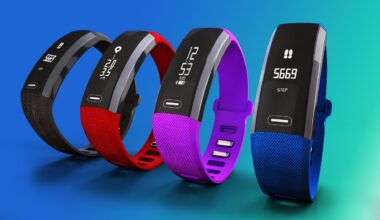Using Technology and Wearables to Monitor Injury Risk in Swimmers
Swimmers are often at risk of injuries due to repetitive motions and intense training regimens. However, advancements in technology, especially wearables, are proving vital in monitoring injury risk among swimmers. With the introduction of sensors and applications designed for aquatic athletes, coaches now have unprecedented access to real-time data that can help prevent injuries before they occur. These technologies can track various performance metrics, including stroke count, heart rate, and muscle strain, allowing for personalized training regimens. Furthermore, analyzing the data collected can highlight any negative patterns that might lead to injury over time. Integrating wearables into daily training routines enables swimmers to be proactive rather than reactive about their health and wellness. Technologies like smart swimsuits and wrist devices provide swimmers with comprehensive insights into their physical conditions. Through motion analysis and biomechanical feedback, swimmers can adjust their techniques, reducing their injury risk. Such innovations are not just beneficial for elite athletes but can also support amateur swimmers and kids. By prioritizing injury prevention through technological means, a safer and healthier swimming experience is within reach for everyone.
The Role of Data Analytics in Injury Prevention
Data analytics plays a pivotal role in understanding patterns that contribute to injuries in swimmers. By collecting vast amounts of data through wearables, coaches and athletes can analyze performance trends to identify risks efficiently. For instance, variations in heart rate and muscle fatigue indicators can alert coaches to potential overtraining situations, prompting adjustments in workloads or techniques. Tracking variables over time enables personalized insights, ensuring each swimmer receives tailored feedback. Moreover, with advances in machine learning, predictive analytics tools can offer future injury forecasts based on individual swimmer profiles. These tools can study combinations of factors like fatigue levels, swimming techniques, and even previous injury history. This ongoing analysis can be instrumental in guiding training decisions to avoid injuries during critical competition phases. Athletes equipped with data-driven insights are better positioned to make informed training decisions, leading to improved performance while minimizing risks. Ultimately, integrating data analytics into swimming training programs allows for an evolved approach to athlete health. Increased awareness and preventive measures enable a culture encouraging wellness and performance. This collaboration of technology and sport promises a bright future for enhanced safety in swimming.
Wearables used in swimming are designed with specific features to ensure accuracy and reliability in monitoring key metrics. For example, smart goggles and swim watches cater specifically to swimmers’ needs, allowing them to obtain real-time feedback without interrupting workouts. These devices often include heart rate sensors, accelerometers, and GPS, providing an all-encompassing view of a swimmer’s performance. Such innovations ensure that athletes receive accurate data even in complex aquatic environments, like varying water depths and strokes. Additionally, the comfort and fit of these devices are crucial so that they do not hinder performance. Regularly updating software and analytics also plays a significant role; wearable devices must evolve to improve their functionalities continually. Swimmers benefit from the seamless integration of these technologies into their training routines. Customizable alert systems can notify athletes when they enter unhealthy thresholds or exhibit fatigue signs. Such presets help promote swift decision-making during training sessions. Furthermore, sharing data with coaches engages athletes in their health journey, allowing for collaborative customizing of training loads. This synergy enhances both performance and overall athlete longevity through conscientious monitoring.
Injury prevention in swimming is not solely about technology; it also involves educating swimmers and coaches about proper techniques and physical conditioning. Athletes must understand how to utilize the data provided by wearables effectively. Proper technique can alleviate stress on susceptible muscles and joints, reducing the risk of injuries. Regular injury-risk assessments can also help identify weaknesses in swimmers and suggest preventive exercises or stretches to strengthen those areas. Coaches play a critical role in creating an environment where swimmers feel comfortable discussing any discomfort during training. This open communication can lead to earlier intervention for potential issues. Incorporating strength and conditioning exercises into training not only enhances performance but also acts as a method of injury prevention through balance and muscle strength. Working collaboratively with health professionals can further improve injury prevention protocols. Regular physiotherapy sessions or strength assessments enable a structured approach to injury safety. Ultimately, establishing an educational framework around injury awareness complements the role of technology in supporting swimmers. By integrating these elements, a comprehensive strategy emerges, focusing on swimmer health and performance excellence.
Future Innovations in Swim Technology
As technology continues to advance, the future of injury prevention and performance monitoring in swimming looks promising. New innovations in smart textiles, incorporating conductive fibers into swimsuits, showcase exciting potential for real-time data collection. Imagine a suit that can monitor muscle flex and strain while adjusting buoyancy for optimal motion. Futuristic wearable technology might also include enhanced AI-driven analytics, suggesting tailored training plans based on accumulated data. Also, the integration of virtual reality training might revolutionize technique refinement, allowing swimmers to visualize and correct their forms without additional strain on their bodies. Collaborations across technology and sports science are crucial to unraveling new methods for injury prevention, with ongoing research and investments supporting these endeavors. Emerging technologies in motion analysis tools can dissect stroke efficiency, leading to personalized adjustments that enhance performance sustainably. Furthermore, integrating community-driven health applications can support a shared platform for swimmers, where they log progress and receive shared insights. The outlook is dynamic as more swimmers join the technology-for-health trend. Thus, it becomes evident that the future of swimming will be significantly shaped by ongoing technological advancements.
Emphasizing injury prevention through technology also brings opportunities for enhanced swimmer engagement. Gamifying training with virtual competitions can motivate swimmers to adhere to their training programs while prioritizing safety. Wearable devices that track fitness levels could integrate with social platforms, creating friendly competition and accountability amongst friends. This communal aspect might boost morale and compliance with training regimens, while constantly reminding athletes about injury prevention. Highlighting achievements and progress through technology impacts swimmers’ mindsets positively, encouraging them to keep pushing themselves while paying attention to their bodies. Combining competition and cooperation leads to a supportive culture around injury prevention and progress tracking. Leading by example, coaches and mentors can further foster this environment, where open discussions about strengths and weaknesses are encouraged. Creating supportive communities around technology in swimming ensures that all levels of athletes benefit from developments in injury prevention strategies effectively. With these renewed focus points, swimming can transition into a progressive sport, integrating health, wellness, and performance in its fabric. Overall, the successful convergence of technology and athlete engagement opens many pathways for enhancing swimmer wellness.
In conclusion, utilizing technology and wearables to monitor injury risk in swimmers holds great promise for fostering a healthier environment in the sport. The value of data analytics, combined with cutting-edge wearable devices, enables swimmers and coaches to approach training with a reinvigorated perspective on health and performance. By understanding injury patterns and adopting preventative measures, athletes can significantly enhance their longevity in the pool. As technology continues to advance, the tools available for monitoring swimmer health and performance will inevitably evolve. Future innovations, such as smart textiles and AI analytics, will redefine how swimming training is approached. At the same time, the added focus on educational programs will ensure that swimmers use these tools effectively. Creating a culture of collaboration and communication among swimmers, coaches, and health professionals is essential to maximizing the benefits of technology. The fusion of technology, education, and swimmer engagement will reshape the landscape of swimming, making injury prevention a core element of training. Thus, the sport can embrace a future where every swimmer can safely thrive, equipped with the insights necessary for reaching their fullest potential.
In conclusion, utilizing technology and wearables to monitor injury risk in swimmers holds great promise for fostering a healthier environment in the sport. The value of data analytics, combined with cutting-edge wearable devices, enables swimmers and coaches to approach training with a reinvigorated perspective on health and performance. By understanding injury patterns and adopting preventative measures, athletes can significantly enhance their longevity in the pool. As technology continues to advance, the tools available for monitoring swimmer health and performance will inevitably evolve. Future innovations, such as smart textiles and AI analytics, will redefine how swimming training is approached. At the same time, the added focus on educational programs will ensure that swimmers use these tools effectively. Creating a culture of collaboration and communication among swimmers, coaches, and health professionals is essential to maximizing the benefits of technology. The fusion of technology, education, and swimmer engagement will reshape the landscape of swimming, making injury prevention a core element of training. Thus, the sport can embrace a future where every swimmer can safely thrive, equipped with the insights necessary for reaching their fullest potential.


